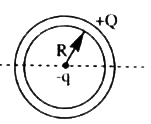A thin conducting spherical shell of radius R has a charge Q which is uniformly distributed on its surface. The correct plot for electrostatic potential due to this spherical shell is




The correct Answer is:B
Topper's Solved these Questions
- BOOK - NCERT TAMILCHAPTER - ELECTROSTATICSEXERCISE - Exercises23videos
ELECTROSTATICS
- BOOK - NCERT TAMILCHAPTER - ELECTROSTATICSEXERCISE - Exercises23videos
ELECTROSTATICS
- BOOK - NCERT TAMILCHAPTER - ELECTROSTATIC POTENTIAL AND CAPACITANCE EXERCISE - ADDITIONAL EXERCISES1videos
ELECTROSTATIC POTENTIAL AND CAPACITANCE
- BOOK - NCERT TAMILCHAPTER - MAGNETISM AND MAGNETIC EFFECTS OF ELECTRIC CURRENTEXERCISE - EVALUATION (IV. Numerical problems)10videos
MAGNETISM AND MAGNETIC EFFECTS OF ELECTRIC CURRENT
Similar Questions
A spherical shell of radius R has a uniformly distributed charge ,then electric field varies as
View SolutionSee the figure here. We have two hollow thin spherical shells A and B of radii R, and R, respectively. Initially as shown in Fig. (i) shell B has a charge + Q which is uniformly distributed over its outer surface but shell B has no charge. At a particular instant the two spherical shells are connected by a thin copper wire as shown in Fig. (ii). After a couple of minutes two spherical shells A and B are disconnected again as shown in Fig. (iii).

Now answer the following questions :
Compare the final electrostatic energy stored in shell A with that in shell B.View Solution
Knowledge Check
- Question 1 - Select One
A spherical shell of radius R has a uniformly distributed charge ,then electric field varies as
Ainside is zero and varies as x−1 outside itBinside is non zero constant and varies as x2 outside itCinside is zero and varies as x−2 outside itDinside is constant and varies as x−1 outside it - Question 2 - Select One
A spherical shell of radius R has a charge +q units. The electric field due to the shell at a point
Ainside is zero and varies as r−1 outside itBinside is constant and varies as r−2Cinside is zero and varies as r−2 outside itDinside is constant and varies as r−1 outside it
See the figure here. We have two hollow thin spherical shells A and B of radii R, and R, respectively. Initially as shown in Fig. (i) shell B has a charge + Q which is uniformly distributed over its outer surface but shell B has no charge. At a particular instant the two spherical shells are connected by a thin copper wire as shown in Fig. (ii). After a couple of minutes two spherical shells A and B are disconnected again as shown in Fig. (iii).

Now answer the following questions :
Find the ratio of surface charge densities of shell A and shell B.View SolutionSee the figure here. We have two hollow thin spherical shells A and B of radii R, and R, respectively. Initially as shown in Fig. (i) shell B has a charge + Q which is uniformly distributed over its outer surface but shell B has no charge. At a particular instant the two spherical shells are connected by a thin copper wire as shown in Fig. (ii). After a couple of minutes two spherical shells A and B are disconnected again as shown in Fig. (iii).

Now answer the following questions :
What is the ratio of final electric potentials of shell A and shell B ?View SolutionA thin spherical shell radius of R has a charge Q uniformly distributed on it. At the centre of the shell, a negative point charge -q is placed. If the shell is cut into two identical hemispheres, still equilibrium is maintained. Then find the relation between Q and q?
 View Solution
View SolutionThere is a hemispherical shell having charge Q uniformly distributed on its surface. Radius of the shell is R. Find electric potential and field at the centre (of the sphere).
View SolutionA thin spherical shell of radius R has charge Q spread uniformly over its surface. Which of the following graphs most closely represents the electric field E(r) produced by the shell in the range 0≤r<∞, where r is the distance from the centre of the shell?
View SolutionA thin spherical shell of radius R has charge Q spread uniformly over its surface. Which of the following graphs most closely represents the electric field E(r) produced by the shell in the range 0≤r<∞, where r is the distance from the centre of the shell?
View Solution

